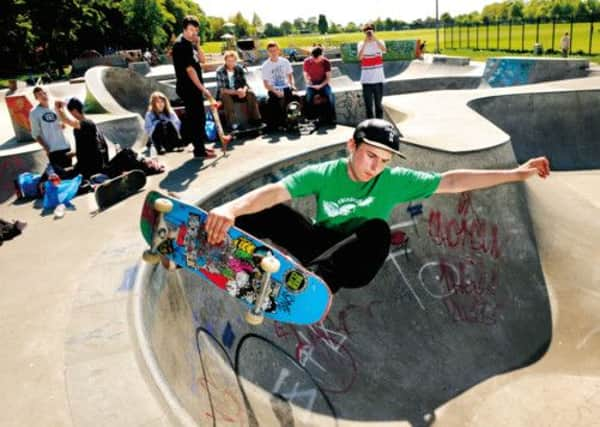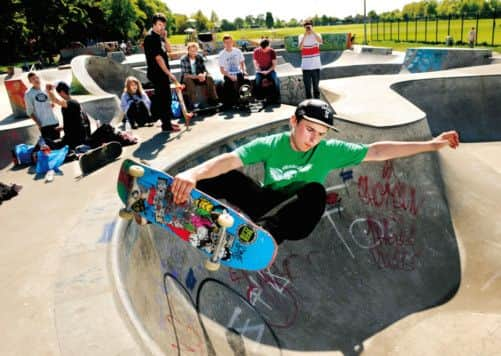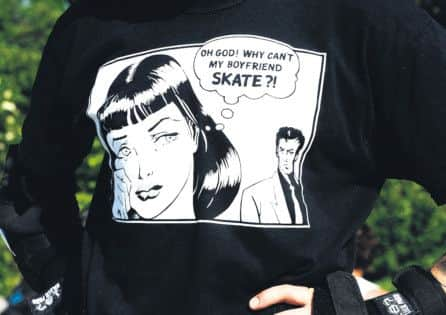Peter Ross: Skateboarding a hard addiction to kick


‘SKATEBOARDING is awesome.” Three words. Uttered on a sultry Edinburgh day by Kerr McLachlan, 21 years old, a skater since he was nine. Just three words, but they say it all, really, about what skating means to its acolytes and devotees, its whirling dervishes in ragged shoes and baggy shorts. Their certainty about its awesomeness – not quite awesome, not pretty awesome, just plain awesome – is similar to the way certain religious fundamentalists feel about their holy books. So: “Skateboarding is awesome.” Amen, Brother Kerr.
The Saughton skatepark in Edinburgh is hoaching when it’s hot. There must be well over a hundred folk here this afternoon, crammed into its undulating architecture, some skating, some sitting around in the sun; drinking beer or juice, consuming pizza by the slice, tobacco by the ounce. The air smells of cut grass, hot concrete and sweat. Kyle Mowat, 20, speeds round the curves, tap aff, with a grace unlikely in one who, not long ago, broke his left leg so badly that the tibia poked through his skin.
Advertisement
Hide AdAdvertisement
Hide AdFag smoke and dandelion clocks drift dreamily past. Sycamores, shading the entrance, are festooned with dozens of pairs of old trainers, revolving slowly by their laces, flung up into the high branches by skaters who have worn them out in the park and so left them here, in the trees, as a tribute to good times past and a votive offering in the hope of even better times to come.


Thursday is, by long tradition, the big night for skateboarding in Edinburgh. The Thursday session. The sesh. The Thursday club. People start turning up from mid-afternoon. All ages: fresh-faced teenage newbies; leathery weather-beaten veterans with lumps and humps from decades of falls. They greet each other with fist-bumps and proffered cans. Everyone has skint elbows, skint knees, and they complain of being skint because all their money goes on boards and wheels. Still, out here in the sun, in the park, nobody thinks too much about jobs and wages. This, for them, is freedom.
“I had no friends until I started skateboarding,” says Kerr. “Then this place opened. When I was younger, if I’d had an argument with my mum or any stress, the best thing to do was just to go skateboarding. Even if you’re just rolling, it blanks your mind. I know a lot of people who don’t do drugs or drink because they’ve got skateboarding. It saves people. But it’s an addiction. The way I look at Edinburgh is different to someone who doesn’t skateboard. The whole city is our playground. The whole world. You’re so free. Skateboarding is endless.”
The Saughton skatepark has been open since 2010 and covers around 2,000 square metres. Its concrete surfaces are motley with graffiti, and its areas have been given affectionate nicknames by the skaters: Middle Earth, The Moshpit, The Bowl, Steep Dave. It is one of two main outdoor skating arenas in the city, the other being Bristo Square, though the two scenes are – I’m told – distinct. Dundee and Aberdeen have sizeable skating cultures, too, as does Glasgow, though Glaswegians tend to skate in the streets rather than in parks. For the skaters of Saughton, though, this place is their pleasure palace. Some get the shakes if they are away from it too long. They are hooked on everything about it, not least the distinctive sound of metal grinding against concrete, a sound so adored it even has its own name – shralp.
“It’s aw aboot the adrenaline, man,” says Scott Bennie, 18. “See when you land a trick? It’s amazin’, eh? The danger gets you hyped on it. See if I land it and I’ve not broken my head open? I’m f***in’ cheesin’ about it. Only way to describe it, man.”


There’s a skatepark etiquette. Every skater takes their turn. Jumping the queue is known as snaking. Even if you’ve been waiting ages, if you come off at the first wall, your turn is over and you go to the back of the queue. And if someone is attempting to learn a new trick, it is considered disrespectful for another skater who can already perform that trick to do so. Generally, it’s a supportive culture. Onlookers are always whooping and hollering praise, yelling out suggestions for tricks that, to the uninitiated, sound gnomic: “Bongo! Show us your rock to fakie!” “Frontside air!”; “That’s sick!”; “That’s rad!”
Bongo is Ali Duncan, 16. He’s from Selkirk, a town with a strong equestrian culture but no skate scene, so he travels to Edinburgh and other parks whenever he can. He was given a board by his grandad when he was eight, and when the old man died he used to go out skating as a way of remembering him. “I don’t know what I’d do if I didn’t skate,” he says. He was, until recently, working in a mill packaging tartan scarves, and would pass the time thinking obsessively about tricks. “When you learn a new trick it’s an ecstatic feeling.”
Delam wanders over. Dylan Berrill is his real name. He’s a student psychiatric nurse, 39 and covered in tattoos; one, on his left leg, says Skate Or Die. “If you’re writing about skateboarding,” he says, “then you’ve got to mention these guys – the modern scourge of the skateparks.” He gestures behind him to a couple of wee boys, pre-schoolers on scooters, playing blithely in the concrete bowl. “Their mums and dads just drop them off into the park like it’s a crèche. You can’t be mean to them because they’re just children. I’ve hit a couple by accident. I body-checked him full-pelt, but managed to grab him in mid-air and turn, so I took the force of the fall on my back. I would have felt horrendous if he had to be taken away in an ambulance.”
Advertisement
Hide AdAdvertisement
Hide AdDylan is one of the older skaters at Saughton. “If you’d told me at 16 that I’d still be skating at almost 40 I’d have laughed at you,” he says. “We used to think that you were done after 25. I remember being 16 and feeling sorry for a mate who was 19; that he was ancient, past it. But a lot of the guys who got started in the late Seventies, early Eighties have just kept going. I feel physically similar to how I did in my twenties. But there’s a little bit more fear comes into it when you’re our age. A lot of the guys are joiners or plumbers or whatever, so if they injure themselves they don’t make a living.”
At about seven o’clock, in part to escape the kids on scooters, a bunch of skaters head over to the park at Livingston, cadging a lift in Iain Young’s big Dodge van, listening to T. Rex and Motorhead as the countryside blurs past. Iain, or Youngo, is – at 38 – an elder statesman of the scene. He is part of Skateboard Scotland, the governing body, and builds skateparks through his company Concreate. He comes from Grangemouth and has been skating since the 1980s, when the scene was still outsiderish and underground – “You got a lot of shit for riding a skateboard. People would be attacking you and chasing you down the street.” He and his pals would break into abandoned warehouses and build ramps; it was the same with the derelict mills in Dundee.
“Livi”, as everyone calls the skatepark at Livingston, dates from 1981. It was one of the first parks in the UK and is known internationally, attracting skaters from far and wide, including famous Americans such as Tony Hawk. It is, therefore, somewhere between a massive public artwork, a historic monument, and a beery hang-out, a kind of Radge Mahal.
“It’s the Scottish skating Mecca,” says Craig Benson, 24, a local skater in a red cap and Scotland football top. “This is our zone.” Livi was the brainchild of Kenny Omond, now “71 going on 17”, an electronics engineer from the area who fell in love with skateboarding while on business in California in 1976. He returned to Livingston determined to build a skatepark, and found that the New Town mindset meant most people in positions of influence were open to the idea. So, in the spring of 1981, Livi opened. “It was madness on a stick,” says Kenny. He and his wife Eleanor operated an open-house policy for skaters, putting people up, driving them to A&E with broken wrists and ankles, and even – on occasion – bailing them out of jail. Kenny still skates, even now, and is “training up” his six-year-old grandson, Kade. He laughs off suggestions that a statue in his honour should be erected at the side of the park. “It sends shivers up my back,” he says, “at night, when it’s dark, and you hear the noise of wheels on concrete.”
Talking to skaters is fascinating. They don’t seem at all like sportsmen; rather more like artists, or even pilgrims of a sort. They speak about skating as a form of creativity, riding a park like musicians playing through a score, each performing in his own unique way, a concept known as “steez”; they speak about it, too, as a warm meditative feeling, a cottonwool blankness. It’s beyond expression, skating, really. It is what it is.
“If you can put into words what a guid time we’re huvin’,” says Mark Burrows, a 40-year-old skater from Tranent, as he stands on his board on the lip at Livi, about to plunge down once more, “then ye’re daein’ a guid job, right there.” «
Twitter: @PeterAlanRoss